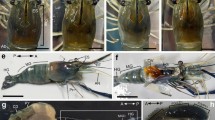Abstract
Evidence is presented in support of the concept that the larval salivary gland of Drosophila melanogaster continues to function as an important secretory organ throughout prepupal stages and after pupation. Just after puparium formation, and at other later periods, the glands appear to be in the process of disintegration, but each time they recover until after pupation. Nuclear blebbing occurs through the time of survival of the glands, but is shown not to involve transport of RNA out of the nucleus. Transport in and out of the nucleus is clearly rapid and in a steady state as compared to the massive and intermittent export of cytoplasmic substance into the lumen of the gland.
Similar content being viewed by others
References
Ashburner, M. (1967). Patterns of puffing activity in the salivary gland chromosomes of Drosophila. I. Autosomal puffing patterns in a laboratory stock of Drosophila melanogaster. Chromosoma 21398.
Bodenstein, D. (1950). In Demeree, M. (ed.), Biology of Drosophila, Wiley, New York, p. 346.
Gay, H. (1956). Nucleocytoplasmic relations in Drosophila. Cold Spring Harbor Symp. Quant. Biol. 21257.
Kaufmann, B. P., and Gay, H. (1958). The nuclear membrane as an intermediary in genecontrolled reactions. Nucleus 157.
Lane, N. J., Carter, Y. R., and Ashburner, M. (1972). Puffs and salivary gland function: The fine structure of the larval and prepupal salivary glands of Drosophila melanogaster. Wilhelm Roux Arch. 169216.
Mitchell, H. K., and Lipps, L. S. (1975). Rapidly labeled proteins on the salivary gland chromosomes of Drosophila melanogaster. Biochem. Genet. 13585.
Mitchell, H. K., and Mitchell, A. V. (1964). Mass culture and age selection in Drosophila. Drosophila Inform. Serv. 39135.
Mitchell, H. K., Weber, U. W., and Schaar, G. (1967). Phenol oxidase characteristics in mutants of Drosophila melanogaster. Genetics 57357.
Revel, J.-P., and Hay, E. D. (1961). Autoradiographic localization of DNA synthesis in a specific ultrastructural component of the interphase nucleus. Exp. Cell Res. 25474.
Ross, E. B. (1939). The postembryonic development of the salivary glands of Drosophila melanogaster. J. Morphol. 65471.
Tissieres, A., Mitchell, H. K., and Tracy, U. M. (1974). Protein synthesis in salivary glands of Drosophila melanogaster: Relation to chromosome puffs. J. Mol. Biol. 84389.
Author information
Authors and Affiliations
Additional information
This work was supported by grants from the National Science Foundation (GB-23343, PCH-02044).
Rights and permissions
About this article
Cite this article
Mitchell, H.K., Tracy, U.W. & Lipps, L.S. The prepupal salivary glands of Drosophila melanogaster . Biochem Genet 15, 563–573 (1977). https://doi.org/10.1007/BF00520198
Received:
Revised:
Issue Date:
DOI: https://doi.org/10.1007/BF00520198




